The Complete Quartzite Countertops Review & Buyer's Guide
Quartzite countertops are quickly gaining popularity due to their unmatched durability and looks-like-marble beauty. But how does it compare to quartz and other countertop materials? This quartzite countetops review and buyer’s guide will cover it all in detail!
Whether replacing kitchen countertops or bathroom vanity tops, the surface you choose is a key decision. It affects cleaning habits, home value, the look of your favorite spaces, and your peace of mind. So, it’s important to find the right material to match the style and the demands of use for that room.
On This Page
- What Is Quartzite?
- Quartzite Colors, Edges & Finishes
- Quartzite Countertop Cleaning & Maintenance
- Pros & Cons of Quartzite Countertops
- What’s the Difference: Quartz vs. Quartzite Countertops
- Granite vs. Quartzite Countertops
- Marble Countertops vs. Quartzite
- Mystery of Quartzite Etching
- How to Buy Quartzite Countertop Slabs
- Quartzite Countertop Cost
- What are the Best Uses for Quartzite Countertops?
Quartzite countertops have a lot to offer, but let’s take a closer look at… colors, cleaning, pros & cons, quartzite vs. quartz, granite and marble, costs, how not to get fooled when buying and a bunch more info to help you decide.
Quartzite Colors, Edges & Finishes
I'll get to the durability, cost, and maintenance needs which are important, but ultimately you want your surfaces to look good! So, will quartzite countertops work with your kitchen design?
Because it’s a naturally occurring stone, there's a large variety of color and pattern options (but not as many as granite) available in two- to three-inch slabs.
Whether you want a cool creamy marble effect or sparkly teal and blue stripes, you have your pick of quartzite for countertops.
The color palette does lean heavily toward whites and grays, but often slabs will have veins or hints of rust, brown, or black and even pink, red, blue, yellow, and green which can be very striking.
You can usually choose between rounded, squared, or fancy edges just like granite or marble.
Quartzite countertops can have a variety of finishes but most are either a honed / brushed matte finish or a polished shiny finish.
The most popular quartzite colors include:
- Azul Macaubas Quartzite – This blue-gray stone adds a big splash of color to your kitchen or outdoor cooktops, with a linear pattern of bright blues against neutral brown and gray base.
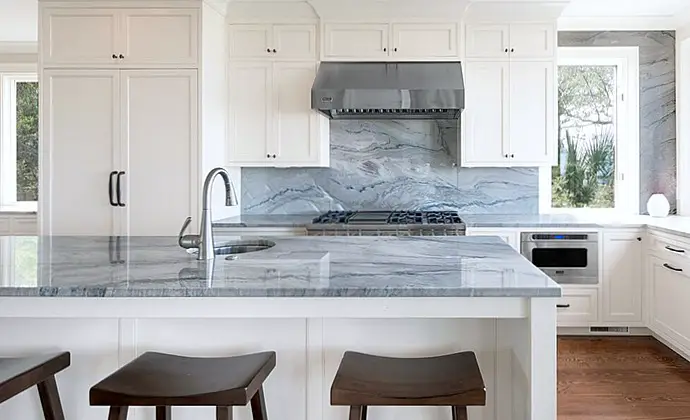 Image Source: AGM Imports
Image Source: AGM Imports- Onyx Bamboo Quartzite – No one will doubt that your countertops are natural stone slabs if you opt for this rocky pattern from Brazil, which has gigantic swirls of purple, brown, and gold.

- White Princess Quartzite – If you love white marble or Corian countertops but need a sturdier surface, the smooth white swirls in this sophisticated pattern will do the trick.

- Ice Flakes Quartzite – Flashes of metallic gold and silver catch the light and make these countertops look like gorgeous glaciers. This pattern complements light wood and tile well.
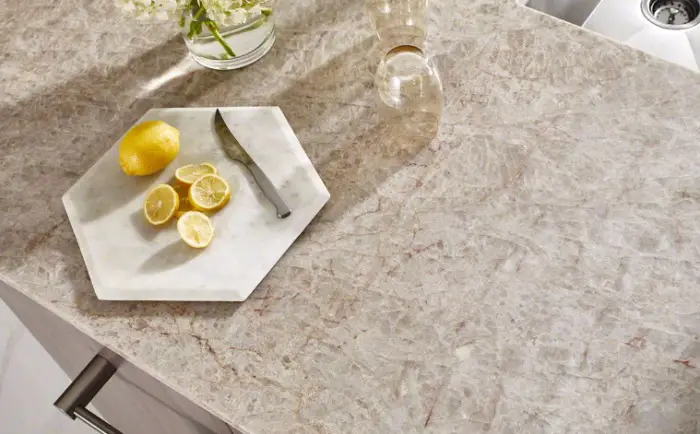 Image Source: MSI
Image Source: MSIOf course, every retailer will offer different variations of these natural stone slabs, and some may have more color and edging options than others. Whatever you do, don’t settle for boring grays and whites if you’re really looking for specks of color or sparkle, or for simple edges if you want more intricate curves.
Quartzite can be as neutral or as show-stopping as you want it to be, especially if your home improvement budget has room for imported slabs and custom edge work.
Quartzite Countertop Cleaning & Maintenance
Quartzite countertop care is essentially the same as for protecting and cleaning granite. Overall durability and performance are on par with granite and quartz countertops. Which is to say that you can’t really get any better, but no surface is perfect.
- Quartzite is not sensitive to acids and doesn’t etch, although sometimes marble and quartzite get mixed up (see more on this below in the “marble vs. quartzite” section).
- Takes heat from hot pots and pans without issue. Cracks from “thermal shock” (sudden change in heat) are possible but rare.
- Quartzite is the hardest countertop material on the market, difficult to chip and next to impossible to scratch.
Okay, so quartzite is super-durable and can stand up to the daily use and abuse of a typical kitchen countertop with relatively low maintenance demands.
Still, it’s best to practice good habits to care for your quartzite. Use a trivet to set hot pans on, don’t let spills sit too long, and apply a sealer if/when needed.
How to Clean Quartzite Countertops
For general daily cleaning...
- Use a damp cloth to wipe up spills and crumbs. Using soap is okay but it will build up a soap scum that dulls the surface if used as a regular cleaner.
- Use a quartzite stone cleaner (same as for granite & marble) for the most effective, streak-free cleaning.
- For extra shine apply a topical stone polish which makes the color really pop and conditions the stone. Do this once a week or as needed.
- If a stain does occur, don’t worry… most stains can be easily removed using the correct stain removal method.
Do Quartzite Countertops Need to be Sealed?
Quartzite is porous and may absorb liquids, so a stone sealer should be applied as needed to prevent stains. Use this sealer test to determine if/when you should apply a sealer.
Resealing frequency can vary from annually (fairly rare), to 3-5 years depending on your particular stone and the quality of sealer used.
PRO TIP: Apply a Permanent Stone Sealer which requires only one round of application initially and then you don't ever have to reapply or reseal the countertops.
Pros & Cons of Quartzite Countertops
While quartzite is one of the most durable and hard surfaces you can choose, it’s less flexible than quartz and more expensive than granite and some marble.
Advantages of Quartzite Countertops
First, the good! Here are some of the most popular reasons to choose quartzite countertops:
- Unique Natural Patterns – If you want your countertops to look and feel like one-of-a-kind natural surfaces, leave it to nature. Quartz and other engineered countertop materials can only mimic the colors, sparkles, and unique patterns of natural stone, but quartzite is the real deal. Every stone slab is unique, and quartzite is known for distinct swirls and patterns that resemble wood, marble, and water.
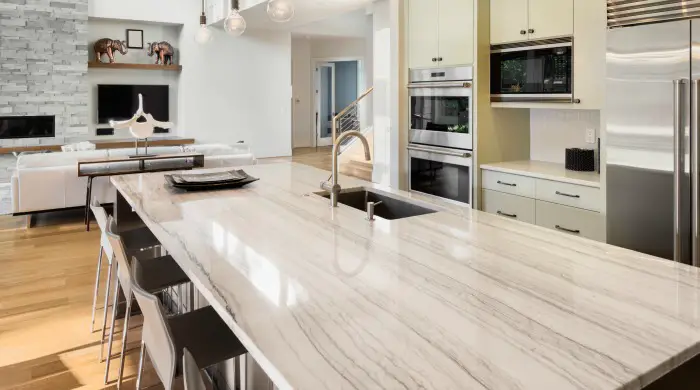
- Neutral, On-Trend Color Schemes – For years, interior design has been getting more neutral and natural. Gray and white are now the most popular color choices for kitchens, especially when it comes to countertops and backsplashes. Gray and white quartzite are the two most common colors of this natural stone.
White Fantasy and other quartzites mimic marble without the spotting and etching. Invest in quartzite countertops to update your kitchen’s color scheme and lay a neutral foundation for future updates.
- Low-Maintenance – No countertop is completely maintenance-free, but quartzite countertops will glisten in the sun and look great with little effort. Most quartzite slabs will need sealing to help prevent stains, however, this is an easy DIY project and typically only needs doing every several years (not “every” year as you often hear).
- Hard and Durable – Quartzite is the hardest of all countertop materials. Even harder than granite. Quartzite will not scratch, etch, or scorch from heat and rarely chips or pits. Simply put, it doesn’t get tougher than quartzite.
Disadvantages of Quartzite Countertops
Like any other surface, there are cons to quartzite countertops too. If you want a sturdy surface that stands up to wear and tear, quartzite is right for the challenge, but you should consider some of these disadvantages first.
- Price – The cost of quartzite countertops leans toward the expensive end of the spectrum but still falls within a range comparable to quartz countertops, granite, and marble. See the “Quartzite Countertops Cost” section below for a complete discussion.
- Needs to Be Sealed – This is actually a pro and a con wrapped up in one. Quartzite is very durable and low-maintenance, except for the sealing. But again, applying a sealer is easy, is only done as needed (every few years, or only once if using a permanent stone sealer.
- May Not Be Genuine – Quartzite and marble can look very similar to the point that sometimes marble slabs are mislabeled as quartzite. Unfortunately, it is not uncommon for people to find this out only after installation. But there is an easy way to avoid this mistake (more below).
What’s the Difference: Quartz vs. Quartzite Countertops
If you think quartzite is a “lite” version of quartz, think again. The two surfaces are actually completely different countertop materials, produced in different ways, but do share some commonalities.
Is Quartz Better Than Quartzite Countertops?
Let’s find out…
Quartz is an engineered countertop. It’s man-made. Manufacturers fuse quartz, a natural mineral, with different resins, stones, glass, and pigments to create durable, non-porous slabs.
Quartzite is a natural stone formed by Mother Nature (like granite or marble) with “quartz” as a primary mineral component.
It’s a metamorphic rock that comes from sand. Originally sand is compressed together to form sandstone and then that sandstone is further transformed or crystallized into the super-hard mineral quartz by the intense heat and pressure within the earth. Since this rock is almost completely composed of quartz, geologists named it “quartzite”.
Various other naturally occurring minerals do get mixed into the quartzite which can result in color and pattern variations, although, most often you’ll see gray and white quartzite countertops.
Quick Comparison: Quartzite vs. Quartz countertops
- Quartzite is a natural stone from the earth. Quartz is man-made.
- Quartzite has more natural and unique patterns. Quartz has more uniform colors and patterns.
- Quartzite is harder than quartz, but both are extremely scratch-resistant.
- Quartzite is chemical-resistant. Quartz can be discolored by some cleaners.
- Quartzite can stain and should be sealed. Quartz does not need sealing.
- Quartzite tolerates heat. Quartz can be scorched by hot pans (but rare).
- Costs fall in a similar range for both quartzite and quartz countertops, however, many variables will influence final cost for either countertop material.
So, how can you tell it’s really quartzite? These two surfaces get mixed up all the time but it can be hard for the average homeowner to see the difference.
Here are a few clues:
- If it is a dark color (brown, black, green) then it’s almost certainly quartz.
- If it is a solid color without a pattern, it’s quartz.
- If it comes in uniform slabs and color patterns, it’s probably a man-made quartz countertop.
- If it came from a quarry, it’s quartzite.
- If the slab has a “brand” name (like Silestone or Caesarstone) then it’s quartz.
It may be hard to see at first, but patterns in natural stones like quartzite tend to be more dramatic, random and non-repeating with larger or longer streaks and veins.
Also, remember that quartzite comes mainly in grays and whites. It can have other colors (blue, rust, gold) but the color range of quartzite is much more limited than quartz or granite.
Quartz countertop patterns tend to be more uniform and consistent across the entire slab. This is especially true of the “classic” quartz patterns that feature a speckled look.
This is beginning to change with the introduction of quartz colors that better resemble the more random and natural patterns seen with granite, marble, and quartzite. Many are just gorgeous.
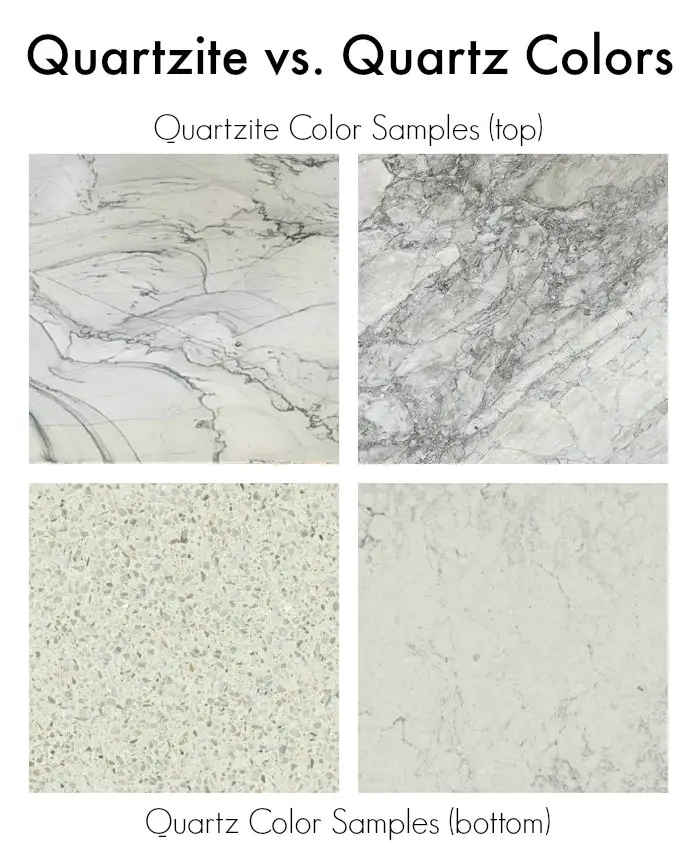
So, in truth, it can be difficult to discern with the untrained eye the difference when comparing quartz vs. quartzite countertops. But even these newer quartz patterns have a consistency or repetition, although, it may cover a larger area and is not so obvious.
Once you look at enough of each (natural stone or quartzite vs. quartz) you’ll notice that quartzite has greater visual depth. Natural stone has a sort of 3D quality to it that engineered stone like quartz countertops cannot replicate.
Quartzite vs. Quartz Maintenance
Maintenance overall is very similar as both are durable surfaces that can stand up to heavy kitchen use. Both are nearly impossible to scratch.
- Quartzite is highly-resistant to chemical damage, although, it can stain (from a substance absorbing into the stone) and will need sealing in most cases.
- Quartz, on the other hand, resists staining and does not need sealing, however, it can be discolored by some common or household chemicals. Sometimes this damage is permanent.
- Quartzite is more heat-tolerant too where the resins used in quartz countertops can melt or scorch by excessive heat or hot pans.
Quartzite countertop cost is similar to quartz with both ranging from about $60 per sq. ft. to $120+ depending on rarity, supply and demand, your location, or the particular “style” of a quartz countertop. Of course, cutouts, edges and other variables influence the total price.
What this means is that you could get a quote for a quartzite countertop that is far higher than one for a quartz countertop…. Or vice versa (quartz more than quartzite) depending on the choices you make.
So, we’ll ask again…
Is Quartzite Better Than Quartz?
All considered, the edge goes to quartzite since it is more durable. Here are the key differences...
- Quartzite can stain and must be sealed, but stains can be removed so no permanent damage.
- Quartz doesn’t need sealing but it can be permanently damaged by some chemicals.
- Quartzite will tolerate heat much better than quartz.
However, they are both excellent surfaces and choosing between one or the other will likely come down to your preference in color and pattern vs. the slightly better performance durability of quartzite.
Granite vs. Quartzite Countertops
Quartzite and granite countertops are very similar in performance and maintenance but do have some differences in available colors and cost.
Similarities
- Contain the mineral “quartz”
- Natural stones formed by Mother Nature (granite forms from lava and other minerals; quartzite from sand and sandstone)
- Sparkle from mineral flecks
- Have veins of color
- Hard and durable
- Tolerate extreme heat from hot pans on the surface
- Won’t scratch
- Won’t etch from acidic foods
- Porous and can stain
- Should be sealed (although some dark granites do not need sealing)
Differences
- Quartzite tends to have lighter colors. Many varieties of white quartzite resemble marble and are very popular. Most granite varieties do not resemble marble although a few do exist.
- Granite offers far more colors with a much wider range of choices.
- Quartzite is more expensive on average but depends on the specific color of quartzite or granite chosen. Some granites can be more expensive.
Is Quartzite Better Than Granite?
For all intents and purposes quartzite for countertops is not better (or worse) than granite. When comparing cleaning, maintenance, durability, and performance they are pretty equal.
Granite does come in a much wider variety of colors and patterns. Quartzite is harder and does not chip or pit like some granite varieties can.
But there is no one thing to point to and say... "Okay... this is the reason to choose quartzite over granite" (or vice versa).
Cost could go either way with one more than the other depending on which color you choose. For these two stones just go with the color and pattern you like best.
Marble Countertops vs. Quartzite
One of the biggest selling points for quartzite is its appearance. Many of the white quartzite colors look like white marble countertops which are always so popular but troublesome as kitchen countertops.
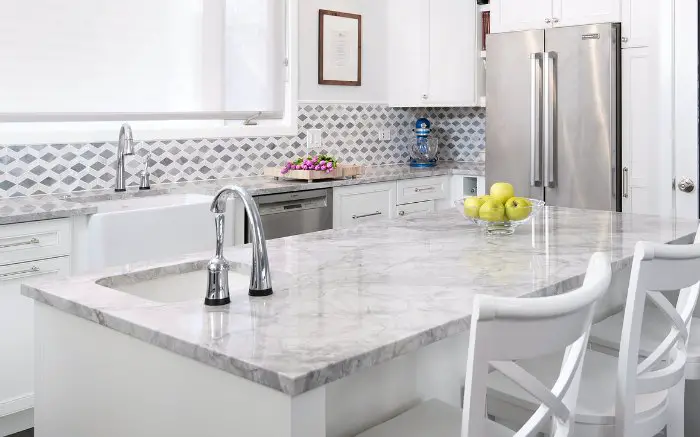 Image Source: Lincthelen Design
Image Source: Lincthelen DesignAs we learned above there’s not much difference between granite and quartzite all considered. It's the opposite with marble.
Marble and quartzite have very different performance characteristics.
Many people love the look of marble but want a surface with less difficult maintenance requirements. This is a primary reason for the recent surge in popularity of quartzite countertops.
- Marble is soft and can be scratched.
- Marble doesn’t tolerate hot pots and pans as well as granite or quartzite.
- Marble can etch immediately upon contact with acidic foods, drinks, or common household cleaners.
Etching is like a chemical burn that corrodes the surface finish creating dull and chalky drips, spots, and glass rings.
Etching can be repaired on marble but it can be a pain to deal with since it will be impossible to guard the surface against contact with acids. Sealing does not prevent etching. This is the main reason marble is often not recommended for kitchen countertops.
The Mystery of Quartzite Etching
It is rumored around the web that some quartzite will etch. While it is possible that a particular quartzite slab could contain enough calcite (the mineral in marble that reacts to acids to cause dull etch marks), in reality, this is not the explanation.
True quartzite does not react to acids and will not etch.
But some homeowners that have quartzite countertops (or think they do) have developed etch marks. So... why?... how?
The real reason that “some quartzite slabs etch” is because they are actually marble slabs and not quartzite. How can that be?
Well, since quartzite (particularly white quartzite) can look nearly identical to white marble (like Carrara marble) it is not uncommon that a slab of marble gets incorrectly identified and labeled (usually at the stone warehouse level) as “quartzite”.
The bugaboo here is that the mistake is often not discovered until the unfortunate homeowner starts getting etch marks on their new “quartzite” countertop.
So, if you love the look of marble, maybe consider quartzite that looks like marble. You have several choices such as Calacatta Macuabus, Taj Mahal, White Fantasy, White Princess and Super White quartzite to name a few.
A second reason quartzite may etch is due to a reaction with the resin that is applied to the surface of many quartzite slabs. Quartzite starts as sandstone that gets crystallized by heat and pressure. It's a super hard stone, but also more brittle and difficult to cut or fabricate than granite.
Applying a resin helps to stabilize the quartzite. The resin is applied at the factory or quarry before it ever arrives at a stone warehouse.
A high-quality resin will not react with acids, but as often happens in the marketplace, many dealers use cheaper resins that will react with acids resulting in dull and chalky spots or ghost-like etch marks just like on marble.
How to Buy Quartzite Countertop Slabs
To avoid the mislabeled quartzite dilemma be sure to perform the Lemon Juice & Oil-Water tests on any natural stone slab you wish to purchase. These tests will tell you everything you need to know about that specific slab regardless of what the salesperson or label says.
Testing will reveal if the stone etches from acids and how absorbent (how likely to stain) it is. Again, test any stone slab you are considering for purchase either at the warehouse or at home using a piece chipped off the exact slab (not a showroom sample).
The page at the above link describes the tests in detail but basically, it’s done like this…
- Squeeze a small puddle of lemon juice onto your stone sample, then another small puddle of oil. Let sit for a few minutes.
- If the countertop starts to look darker underneath the oil, it indicates how susceptible to staining it is based on the time it took to darken. The longer it takes to darken under oil, the easier it is to prevent stains with a stone sealer.
- If the lemon juice starts to fizz and bubble it means that the stone will etch. Wipe off the lemon juice after a few minutes, and see if it leaves a dull or chalky spot. You may have to view it at a low angle to see the lack of shine. If so, it’s marble, not quartzite
The lemon juice test is more important because it will tell you if your “quartzite” sample is true quartzite or actually marble mislabeled as quartzite.
Also, you can try and scratch the surface using a knife or screwdriver. Marble will scratch. Quartzite will not scratch or it will be only a very light surface mark barely perceptible.
Naturally, the best stone slabs for kitchen countertops are those that don’t etch, or scratch, or scorch from heat, and take a long time to absorb liquids.
A true quartzite slab will not etch. It will likely absorb liquids within a few minutes similar to many granite slabs. However, absorption and staining can be controlled with proper sealing.
Quartzite Countertop Cost
Installed costs of quartzite countertops will vary depending on the color/pattern you pick, how rare or popular it is, your location, the complexity of countertop configuration, number and type of cutouts for sinks, faucets, cooktop, and the edge style chosen.
- Expect to pay $70 up to $200 per square foot.
It is possible to get a lower price, although on average, quartzite is more expensive than granite, marble, or quartz countertops. But remember, every type of countertop material has a range of prices, so you could get a quote for granite that is more expensive than quartzite, or for quartz that is more expensive.
For instance, white quartzite has fewer impurities, is rarer and thus more expensive. All the white and gray quartzite colors can be more expensive simply because they are the most popular even though white and gray is the most common type of quartzite.
However, other darker colors of quartzite can be much less than many marble or granite colors.
The lesson here is that cost estimates and comparisons can be useful as a general guide, but they can be wildly different on a case by case basis.
So, you just need to pick out a few colors and countertop materials you like, get quotes for each with all the same specs (cutouts, edge treatments), and then decide which is all-around best for you.
What are the Best Uses for Quartzite Countertops?
When it comes to choosing the right countertop, it’s not enough to compare the cost, appearance, or quality of each material by itself. To find the superior option for your home, you also need to consider how you’ll be using the surfaces.
From water and oil spills to hot pans and sharp blades, abuse is inevitable in kitchens. Fortunately, quartzite is up to the challenge.
Quartzite is such a hard, durable surface that it can sustain a lot of daily wear and tear. It’s recommended for kitchen countertops and bathroom vanity tops alike because it lasts a long time and won’t crack or chip with everyday impact.
If you have an active family or spend a lot of time in the kitchen, the investment will be worthwhile, because you won’t have to worry as much about maintaining or damaging your countertops.
Quartzite countertops can take all you and your family can dish out and remain looking new and brilliant with nearly carefree maintenance.
With smart everyday use, you can make sure your quartzite stays shiny and smooth for years to come.



